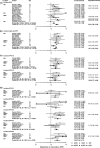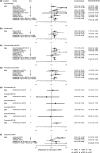Evidence of synergistic relationships between HIV and Human Papillomavirus (HPV): systematic reviews and meta-analyses of longitudinal studies of HPV acquisition and clearance by HIV status, and of HIV acquisition by HPV status
- PMID: 29873885
- PMCID: PMC5989783
- DOI: 10.1002/jia2.25110
Evidence of synergistic relationships between HIV and Human Papillomavirus (HPV): systematic reviews and meta-analyses of longitudinal studies of HPV acquisition and clearance by HIV status, and of HIV acquisition by HPV status
Abstract
Introduction: Observational studies suggest HIV and human papillomavirus (HPV) infections may have multiple interactions. We reviewed the strength of the evidence for the influence of HIV on HPV acquisition and clearance, and the influence of HPV on HIV acquisition.
Methods: We performed meta-analytic systematic reviews of longitudinal studies of HPV incidence and clearance rate by HIV status (review 1) and of HIV incidence by HPV status (review 2). We pooled relative risk (RR) estimates across studies using random-effect models. I2 statistics and subgroup analyses were used to quantify heterogeneity across estimates and explore the influence of participant and study characteristics including study quality. Publication bias was examined quantitatively with funnel plots and subgroup analysis, as well as qualitatively.
Results and discussion: In review 1, 37 publications (25 independent studies) were included in the meta-analysis. HPV incidence (pooled RR = 1.55, 95% CI: 1.29 to 1.88; heterosexual males: pooled RR = 1.95, 95% CI: 1.62, 2.34; females: pooled RR = 1.63, 95% CI: 1.26 to 2.11; men who have sex with men: pooled RR = 1.36, 95% CI: 1.01 to 1.82) and high-risk HPV incidence (pooled RR = 2.20, 95% CI: 1.90 to 2.54) was approximately doubled among people living with HIV (PLHIV) whereas HPV clearance rate (pooled RR = 0.53, 95% CI: 0.42 to 0.67) was approximately halved. In review 2, 14 publications (11 independent studies) were included in the meta-analysis. HIV incidence was almost doubled (pooled RR = 1.91, 95% CI 1.38 to 2.65) in the presence of prevalent HPV infection. There was more evidence of publication bias in review 2, and somewhat greater risk of confounding in studies included in review 1. There was some evidence that adjustment for key confounders strengthened the associations for review 2. Misclassification bias by HIV/HPV exposure status could also have biased estimates toward the null.
Conclusions: These results provide evidence for synergistic HIV and HPV interactions of clinical and public health relevance. HPV vaccination may directly benefit PLHIV, and help control both HPV and HIV at the population level in high prevalence settings. Our estimates of association are useful for mathematical modelling. Although observational studies can never perfectly control for residual confounding, the evidence presented here lends further support for the presence of biological interactions between HIV and HPV that have a strong plausibility.
Keywords: HIV; HPV; epidemiology; humans; incidence; meta-analysis; sexually transmitted infections; systematic review.
© 2018 The Authors. Journal of the International AIDS Society published by John Wiley & sons Ltd on behalf of the International AIDS Society.
Figures





References
-
- World Health Organization . Human papillomavirus (HPV) and cervical cancer: Fact sheet. Available from: http://www.who.int/mediacentre/factsheets/fs380/en/[cited 2016 April 08]
-
- Stanley MA, Sterling JC. Host responses to infection with human papillomavirus. Curr Probl Dermatol. 2014;45:58–74. - PubMed
-
- World Health Organization . Human papillomavirus (HPV). Available from: http://www.who.int/immunization/diseases/hpv/en/[cited 2016 April 08]
-
- World Health Organization . Cervical Cancer: Estimated Incidence, Mortality and Prevalence Worldwide in 2012. Available from: http://globocan.iarc.fr/old/FactSheets/cancers/cervix-new.asp [cited 2016 April 04]
-
- UNAIDS . The Gap Report. Available from: http://www.unaids.org/sites/default/files/media_asset/UNAIDS_Gap_report_... [cited 2016 April 04]
Publication types
MeSH terms
Substances
Grants and funding
LinkOut - more resources
Full Text Sources
Other Literature Sources
Medical

